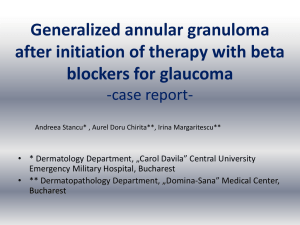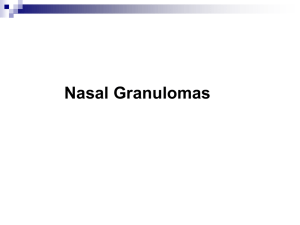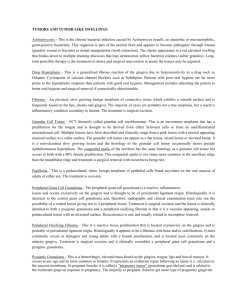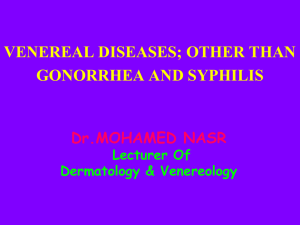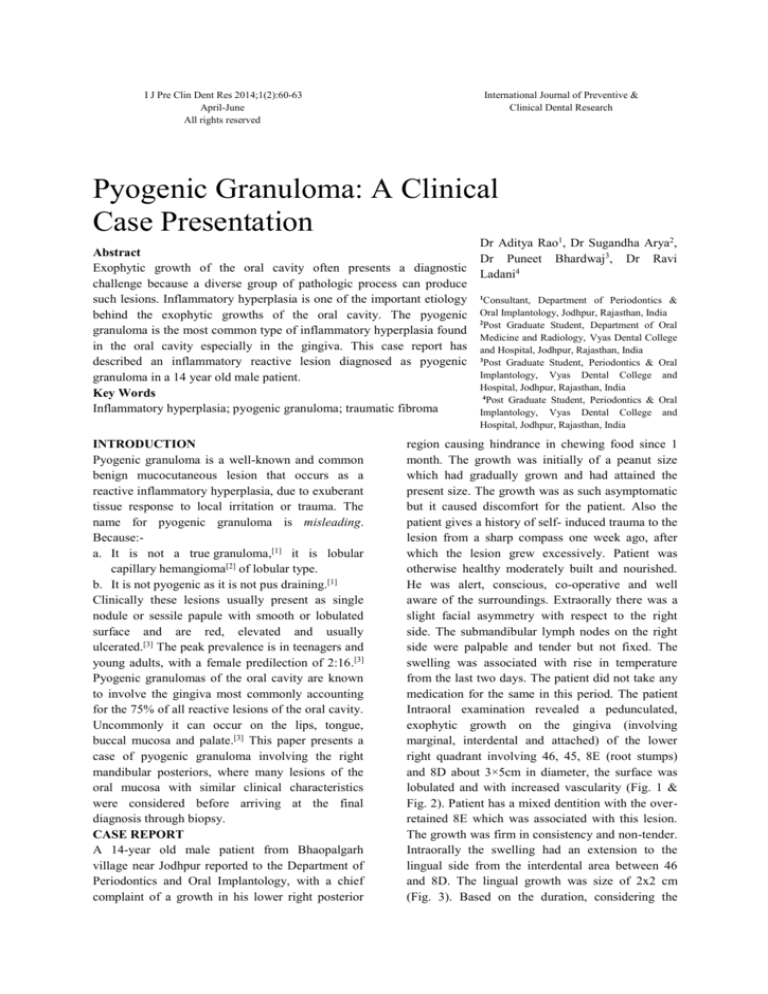
I J Pre Clin Dent Res 2014;1(2):60-63
April-June
All rights reserved
International Journal of Preventive &
Clinical Dental Research
Pyogenic Granuloma: A Clinical
Case Presentation
Abstract
Exophytic growth of the oral cavity often presents a diagnostic
challenge because a diverse group of pathologic process can produce
such lesions. Inflammatory hyperplasia is one of the important etiology
behind the exophytic growths of the oral cavity. The pyogenic
granuloma is the most common type of inflammatory hyperplasia found
in the oral cavity especially in the gingiva. This case report has
described an inflammatory reactive lesion diagnosed as pyogenic
granuloma in a 14 year old male patient.
Key Words
Inflammatory hyperplasia; pyogenic granuloma; traumatic fibroma
INTRODUCTION
Pyogenic granuloma is a well-known and common
benign mucocutaneous lesion that occurs as a
reactive inflammatory hyperplasia, due to exuberant
tissue response to local irritation or trauma. The
name for pyogenic granuloma is misleading.
Because:a. It is not a true granuloma,[1] it is lobular
capillary hemangioma[2] of lobular type.
b. It is not pyogenic as it is not pus draining.[1]
Clinically these lesions usually present as single
nodule or sessile papule with smooth or lobulated
surface and are red, elevated and usually
ulcerated.[3] The peak prevalence is in teenagers and
young adults, with a female predilection of 2:16.[3]
Pyogenic granulomas of the oral cavity are known
to involve the gingiva most commonly accounting
for the 75% of all reactive lesions of the oral cavity.
Uncommonly it can occur on the lips, tongue,
buccal mucosa and palate.[3] This paper presents a
case of pyogenic granuloma involving the right
mandibular posteriors, where many lesions of the
oral mucosa with similar clinical characteristics
were considered before arriving at the final
diagnosis through biopsy.
CASE REPORT
A 14-year old male patient from Bhaopalgarh
village near Jodhpur reported to the Department of
Periodontics and Oral Implantology, with a chief
complaint of a growth in his lower right posterior
Dr Aditya Rao1, Dr Sugandha Arya2,
Dr Puneet Bhardwaj3, Dr Ravi
Ladani4
1
Consultant, Department of Periodontics &
Oral Implantology, Jodhpur, Rajasthan, India
2
Post Graduate Student, Department of Oral
Medicine and Radiology, Vyas Dental College
and Hospital, Jodhpur, Rajasthan, India
3
Post Graduate Student, Periodontics & Oral
Implantology, Vyas Dental College and
Hospital, Jodhpur, Rajasthan, India
4
Post Graduate Student, Periodontics & Oral
Implantology, Vyas Dental College and
Hospital, Jodhpur, Rajasthan, India
region causing hindrance in chewing food since 1
month. The growth was initially of a peanut size
which had gradually grown and had attained the
present size. The growth was as such asymptomatic
but it caused discomfort for the patient. Also the
patient gives a history of self- induced trauma to the
lesion from a sharp compass one week ago, after
which the lesion grew excessively. Patient was
otherwise healthy moderately built and nourished.
He was alert, conscious, co-operative and well
aware of the surroundings. Extraorally there was a
slight facial asymmetry with respect to the right
side. The submandibular lymph nodes on the right
side were palpable and tender but not fixed. The
swelling was associated with rise in temperature
from the last two days. The patient did not take any
medication for the same in this period. The patient
Intraoral examination revealed a pedunculated,
exophytic growth on the gingiva (involving
marginal, interdental and attached) of the lower
right quadrant involving 46, 45, 8E (root stumps)
and 8D about 3×5cm in diameter, the surface was
lobulated and with increased vascularity (Fig. 1 &
Fig. 2). Patient has a mixed dentition with the overretained 8E which was associated with this lesion.
The growth was firm in consistency and non-tender.
Intraorally the swelling had an extension to the
lingual side from the interdental area between 46
and 8D. The lingual growth was size of 2x2 cm
(Fig. 3). Based on the duration, considering the
61 Pyogenic granuloma
Rao A, Arya S, Bhardwaj P, Ladani R
Fig. 1: Buccal view of the intraoral site with
the swelling with respect to 46-8D
Fig. 2: Occlusal view (mirror view) of the
intraoral swelling
Fig. 3: Lingual extension of the intraoral
swelling (mirror view)
Fig. 4: OPG view
Fig. 5: Excised tissue
Fig. 6: Histopathological picture
Fig. 7: Postoperative view after the surgical
excision
patient’s age and clinical features a working
diagnosis of irritational fibroma was given. A
differential diagnosis of traumatic fibroma and
pyogenic granuloma were also considered.
Investigations such as bleeding time, clotting time,
haemoglobin percentage and total leukocyte count
were carried out. Results of which were found to be
normal. The OPG was taken of the whole dentition
(Fig. 4). An incisional biopsy was carried out under
antibiotic coverage along with the extraction of root
stumps of 8E (Fig. 5). Biopsy results showed areas
of ulcerated stratified squamous keratinized
epithelium with underlying granulation tissue (Fig.
6). Numerous varied calibre of blood vessels
arranged in lobular pattern were seen in the
connective tissue suggestive of lobular capillary
hemangioma, a histological terminology for
pyogenic granuloma. Under standard aseptic
conditions the treatment was carried out. Inferior
alveolar nerve block along with long buccal and
lingual nerve block was given with the local
anaesthetic solution. The treatment plan proposed
was first to mark the borders with electrocauttery so
that the bleeding from the site could be limited,
which was later followed by surgical excision. Post
excision period was uneventful with a regular
follow up of 1 month interval, which showed no
evidence of recurrence (Fig. 7).
62 Pyogenic granuloma
DISCUSSION
Pyogenic granuloma (PG) of the oral cavity is a
relatively common entity first described by Poncet
and Dor in 1897 as human botryomycosis.[4]
Hullihen’s description in 1844 was most likely the
first pyogenic granuloma reported in English
literature, but the term “pyogenic granuloma” or
“granuloma pyogenicum” was introduced by
Hartzell in 1947. The incidence of PG has been
described to be between 26.8 and 32% of all the
reactive lesions.[5] Pyogenic granuloma occurs most
commonly in the gingiva. Other sites include
extragingival areas like lips, tongue and buccal
mucosa. Jafarzadeh et al., defined pyogenic
granuloma as an inflammatory overgrowth of the
oral mucosa which was caused by minor trauma or
irritation.[6] According to Neville et al., these
injuries may be caused in the mouth by a gingival
inflammation which was caused due to a poor oral
hygiene, trauma or a local infection. In the present
case, consistent trauma inflicted by the root stumps
may be the cause for the lesion in this location.
Originally, pyogenic granulomas were believed to
be botryomycotic infection which was transmitted
from horse to man. Subsequently it was proposed
that these lesions are caused due to some pyogenic
bacteria like Streptococci and Staphylococci.
However there is no evidence of any infectious
organisms isolated from the lesions confirming the
unlikely relation to any infection and hence the
name is a misnomer.[1] The tissues react in a
characteristic manner resulting in overzealous
proliferation of a vascular type of connective tissue.
The reason attributed to such connective tissue
proliferation varies from trauma to hormonal factors
which along with poor oral hygiene cause tissue
irritation and inflammation and contribute to the
lesion development. The increased incidence of
these lesions during pregnancy may be related to the
increased levels of estrogen and progesterone. The
hormonal imbalance coincident with pregnancy
heightens the organism’s response to irritation;
however bacterial plaque and gingival inflammation
are necessary for subclinical hormone alterations
leading to gingivitis and pyogenic granuloma
formation. The pathogenesis of pyogenic granuloma
at the molecular level may be considered as the
imbalance of the angiogenesis enhancers and
inhibitors. There is over production of VEGF-the
vascular endothelial growth factor; bFGF-the basic
fibroblast growth factor and decreased amounts of
angiostatin, thrombopsondin-1, and the oestrogen
Rao A, Arya S, Bhardwaj P, Ladani R
receptors lead to the formation of pyogenic
granuloma.[7] Clinically, the lesion typically appears
as red to pink nodular growth depending upon the
duration and vascularity of the lesion.[3] The surface
of the lesion can show areas of erythema and
ulceration as was seen in the present case, which
indicate impingement of the lesion during functions
like mastication. Although pyogenic granuloma can
be diagnosed clinically, atypical presentations lead
to inappropriate diagnosis and should be further
investigated by biopsy to rule out any other serious
lesions. The histopathology of pyogenic granuloma
of the gingiva shows proliferating vascular core in
the connective tissue stroma with acute and chronic
inflammatory infiltrates depending upon the
etiology and duration of the lesion. Depending on
its rate of proliferation and vascularity, there are 2
histologicalvariants of pyogenic granuloma called
Lobular Capillary Hemangioma (LCH type) and
Non lobular Capillary Hemangioma (non- LCH
type). Numerous small and larger endothelium-lined
channels are formed, that are engorged with red
blood cells. These vessels are sometimes organized
in lobular aggregates and some pathologists look for
this lobular arrangement to make a diagnosis of
lobular capillary hemangioma. In view of its clinical
characteristics, the differential diagnosis of
pyogenic granuloma includes peripheral giant cell
granuloma, peripheral ossifying fibroma, irritation
or traumatic fibroma, benign salivary gland tumour
and
Non-Hodgkin’s
lymphoma.
Pyogenic
granuloma is treated conservatively by surgical
excision. Surgical excision and removal of causative
irritants are among the choice of treatment. Other
forms of treatment include Nd: YAD laser,
electrocauttery, flash lamp pulsed dye laser,
cryosurgery, intralesional injection of etanol or
corticosteroid and sodium tetradecyl sulphate
sclerotherapy have been produced.[8]
CONCLUSION
Although pyogenic granuloma can be diagnosed
clinically,
atypical
presentations
lead
to
inappropriate diagnosis and should be further
investigated by biopsy to rule any other serious
lesions, before the final diagnosis is made and
adequate treatment is instituted.
REFERENCES
1. Shafer WG, Hine MK, Levy BM: A textbook
of oral pathology, 4thed, WB Saunders,
Philadelphia,1983.
63 Pyogenic granuloma
2.
3.
4.
5.
6.
7.
8.
Wood NK, Goaz PW. Differe ntial diagnosis
of oral and maxillofacial regions. 5th ed.
Missouri: Mosby; 1997.
Regezi JA, sciubba , James J, Jordan Richors
CK: Oral Pathology, clinical pathologic
correlation Fourth edition. Sanders Company;
2003.
Deshmukh J, Kulkarni VK, Katti G,
Deshpande S. Pyogenic Granuloma: An
Unusual Presentation In Pediatric Patient - A
Case Report. Indian Journal of Dental
Sciences. 2013;1(5).
Selvamuthukumar SC, Ashwath N, Anand V.
Unusual presentation of pyogenic granuloma
of buccal mucosa. Journal of Indian academy
of
oral
medicine
and
radiology.
2010;22(4):S45-7.
Jafarzadeh H, Sanatkhani M, Mohtasham N.
Oral Pyogenic Granuloma Review. Journal of
Oral Science. 2006;48(4):167-75.
Kamal R, Dahiya P, Puri A. Oral pyogenic
granuloma:
Various
concepts
of
etiopathogenesis. Journal of oral and
maxillofacial pathology. 2012;16(1).
Kamala KA, Ashok L, Sujatha GP. Pyogenic
Granuloma on the Upper Labial Mucosa: A
Case Report. Journal of Clinical and
Diagnostic Research. 2013;7(6):1244-6.
Rao A, Arya S, Bhardwaj P, Ladani R

